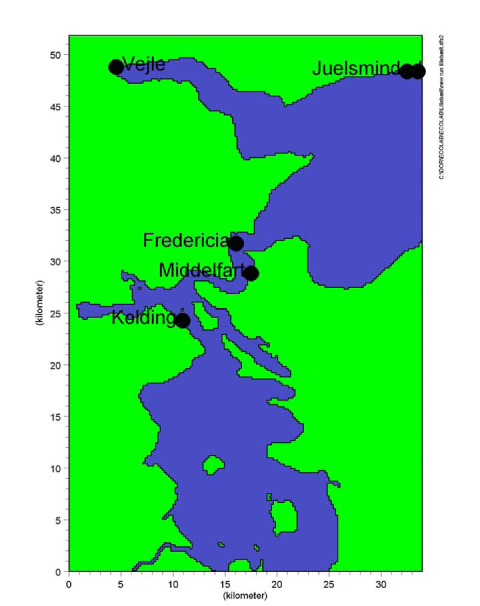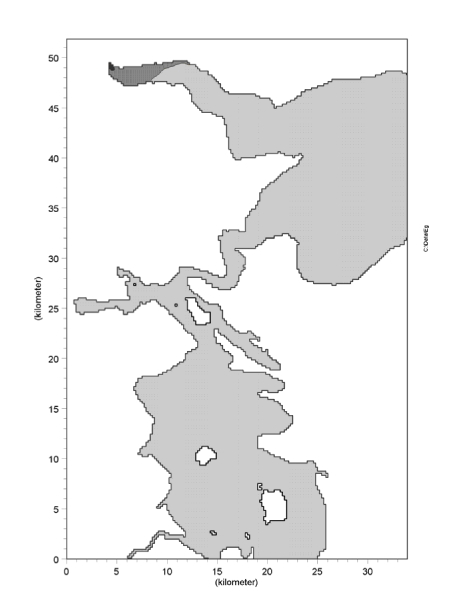Survey of chemical substances in cleaning products for ovens, cookers and ceramic cooktops
7 Effects in the aquatic environment
- 7.1 Substances selected for assessment of their effects in the aquatic environment
- 7.2 Fate of the chemical substances in household products
- 7.3 Estimated total consumption of petroleum distillates and white spirit in the products
- 7.4 Calculation of predicted environmental concentration (PEC) and predicted no effect concentration (PNEC)
- 7.5 Calculation of risk quotients
- 7.6 Exposure scenario: The Little Belt
7.1 Substances selected for assessment of their effects in the aquatic environment
Based on the environmental assessment in Chapter 6 of the four selected substances, petroleum distillates and white spirit, respectively, were selected for a more detailed assessment of effects in the aquatic environment as both groups of substances are considered to be toxic to aquatic organisms and to potentially cause adverse long-terms effects in the aquatic environment.
7.2 Fate of the chemical substances in household products
Chemical substances in cleaning agents used in households will primarily be discharged to the environment via treated waste water from municipal wastewater treatment plants (WWTP). The cleaning agents are flushed with the slops to the sewage system and led to the WWTP. In the WWTP, the chemical substances undergo several processes such as degradation under aerobic and anaerobic (deoxidized) conditions, sorption to sludge particles, volatilization, hydrolysis, etc. The part of the chemical substances discharged with the treated waste water thus depends on the fate of the substances in the WWTP. Also in the aquatic environment, various biological and abiotic elimination processes influence the concentration of the chemical substances. Furthermore, the concentration will depend on hydraulic parameters as e.g. mixing/dilution and water flow conditions.
7.3 Estimated total consumption of petroleum distillates and white spirit in the products
7.3.1 Petroleum distillates
The annual maximum concentration of petroleum distillates discharged as a result of the application of ceramic cooktop cleaners was estimated on the basis of the following assumptions:
- Maximum annual sale of products for ovens and ceramic cooktops: 600,000 products
- The products contained an average of 0.25 litres
- The density of the products was assumed to be 1 g/L
- Products for ceramic cooktops constituted 65 % of the total consumption
- 22 % of the products for ceramic cooktops contained petroleum
- The average concentration of petroleum in these products was 11 %
It was thus estimated that 2,360 kg petroleum are used in products for ceramic cooktops annually.
7.3.2 White spirit
The annual maximum concentration white spirit discharged as a result of the application of stainless steel care products was estimated on the basis of the following assumptions:
- Maximum annual sale of stainless steel care products: 100,000 products
- The products contained an average of 0.25 litres
- The density of the products was assumed to be 1 g L-1
- Percentage of products containing white spirit: 75 %
- Average content of white spirit in the products: 25 %
It was thus estimated that 4,690 kg white spirit are used in products for stainless steel care annually.
7.4 Calculation of predicted environmental concentration (PEC) and predicted no effect concentration (PNEC)
For the estimation of the environmental risk of discharge of petroleum distillates and white spirit, the Predicted Environmental Concentration (PEC) was compared with the concentration of the substance, at which no effects are expected in the aquatic environment, the Predicted No Effect Concentration (PNEC). The concentration of substances in the discharge from WWTPs (PECWWTP) was calculated on the basis of the amounts (M) of substance consumed, the degree of removal in the WWTPs (fremoval) and the annual amount of discharged waste water in Denmark (Q):
![]()
Q = 611 mill. m³/year /35/
fremoval available in reference tables in the EU Technical Guidance Document (TGD) /14/
fremoval is a function of the octanol-water partition coefficient (log POW), Henry’s law constant (H) and the biodegradability of the substances
Table 7.1 shows the calculated PECWWTP values.
| Substance | PECstp, (µg L-1) |
|---|---|
| Petroleum distillates | 1.54 |
| White spirit | 4.99 |
The highest concentrations not expected to cause effects in the aquatic environment, PNEC, are calculated on the basis of data of the toxicity of the substances towards aquatic organisms using an assessment factor as described in the EU Technical Guidance Document /14/. Table 7.2 gives the calculated PNEC values for the selected substances, see also subsection 6.4.3.
| Substance | Lowest effect value (mg L-1) |
Assessment factor | PNEC (µg L-1) |
|---|---|---|---|
| Petroleum distillates | 0.5 (NOEC, algae) /12/ |
100 | 5.0 |
| White spirit | 2.6 (EC50, crustacean) /12/ |
10,000 | 0.26 |
7.5 Calculation of risk quotients
The calculated risk quotients (RQ) for the selected substances are given in Table 7.3. RQ is calculated as PEC/PNEC.
| Substance | PECstp (µg L-1) |
PNEC (µg L-1) |
RQ (PEC/PNEC) |
|---|---|---|---|
| Petroleum distillates | 1.54 | 5.0 | 0.3 |
| White spirit | 4.99 | 0.26 | 16.6 |
A risk quotient > 1 indicates probability of effects in the aquatic environment. A dilution factor of 10 after discharge of treated waste water was assumed. Risk quotients < 10 will thus indicate that there is not considered to be any risk of adverse effects in the aquatic environment. Table 7.3 shows that the risk quotient for petroleum distillates in the discharge from WWTPs is below 1 for which reason petroleum distillates are not expected to cause any effects. For white spirit, the RQ is > 10 and discharge of this substance must be expected to cause a risk of effects in the aquatic environment. In order to assess the effect in the aquatic environment, simulations were made of the dilution and the transformation of white spirit in the environment of a defined exposure scenario.
7.6 Exposure scenario: The Little Belt
For the estimation of the concentration (PEC) of the selected chemical substances, a fate model describing degradation (biodegradation, hydrolysis, photolysis), evaporation and sedimentation was applied. All processes were specified as first order expressions with regard to the substance concentration. The process specifications were entered into a template in the modelling tool ECOLAB developed by DHI. In order to describe the transport of the substances, the fate model was linked to a hydraulic model, which models water flows in a defined water body. In this example, the two-dimensional model MIKE 21 was applied (the vertical distribution was assumed to be uniformly distributed). Furthermore, the Little Belt was chosen as a representative exposure scenario describing coastal areas in Denmark. The area covered by the model was approx. 35 km ´ 50 km.
In order to ensure that the simulation attained some kind of equilibrium, a simulation period of 2 months was applied. The weather conditions observed in the first week of April 2004 were repeatedly applied (approx. 10 times) in the simulation.
Table 7.4 and Figure 7.1 show the characteristics and location, respectively, of the 5 WWTPs discharging the substances into the Little Belt.
| Kolding | Middelfart | Fredericia | Vejle | Juelsminde | |
|---|---|---|---|---|---|
| Waste water, (1,000 m³ d-1) | 26.4 | 11.5 | 30.2 | 33.1 | 3.2 |
| Treatment * | MBNDC | MBNDC | MBNDC | MBNDC | MBNDC |
* M: mechanical; B: biological; N: nitrification; D: denitrification; C: chemical precipitation

Figure 7.1. Location of discharges from WWTPs into the Little Belt
PEC (Predicted Environmental Concentration) for the selected chemical substances was thus estimated by linking the fate of the chemical substances in WWTP and the aquatic environment with the flow behaviour of the Little Belt. The PEC values were related to the PNEC (Predicted No Effect Concentration) of the substances, which is the highest concentration at which no adverse effects in the aquatic environment are expected, and a risk quotient (RQ = PEC/PNEC) was estimated for the substances after discharge into the aquatic environment.
During the simulation period, large variations in the concentrations of the chemical substances in the aquatic environment occur as a result of the natural variation in the flow behaviour. In order to assess potential chronic effects, the average concentration of white spirit throughout the simulation period was estimated and compared with PNEC. For the assessment of potential acute effects, the maximum concentration of white spirit throughout the simulation period was estimated and compared with 10 ´ PNEC as it is generally assumed that PNEC for acute effects is a factor of 10 higher than PNEC for chronic effects.
The result of the simulations for white spirit was expressed graphically by specifying the risk quotients in the following intervals: RQ ≤ 0.1; RQ 0.1-1 and RQ ≥1 for the different areas of the Little Belt. The area of the Little Belt, in which there is a risk of acute effects, was found to be considerably smaller than the area, in which there is a risk of chronic effects. Figure 7.2 shows the estimated risk quotients (chronic effects) found as the ratio of the time-weighted average of the estimated concentration to PNEC.

Figure 7.2. Risk quotients for chronic effects of white spirit in the Little Belt. indicates RQ ≥ 1; indicates RQ between 0.1-1; indicates RQ ≤ 0.1
The result of the simulation showed that, for white spirit, risk quotients > 1 were found for chronic effects in a limited near zone around the waste-water discharge from Vejle WWTP. In the other areas of the Little Belt scenario, no risk of adverse effects from white spirit was found. The inner part of Vejle Bay is characterised by a limited water exchange compared with the other wastewater discharges into the Little Belt. It was thus not surprising that the highest probability of effects occurred in exactly this area. The estimates express a worst-case situation with a high estimated consumption of stainless steel care products. Based on the simulations made for the Little Belt, it can be concluded that the discharge of white spirit may cause adverse long-term effects in the aquatic environment in a limited near zone around waste-water discharges when, at the same time, the area is characterised by a limited water exchange. No risk quotients > 1 were found for acute effects in the Little Belt (data not shown).
Version 1.0 December 2010, © Danish Environmental Protection Agency